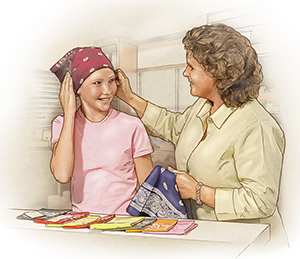A
B
C
D
E
F
G
H
I
J
K
L
M
N
O
P
Q
R
S
T
U
V
W
X
Y
Z
Click a letter to see a list of conditions beginning with that letter.
Click 'Topic Index' to return to the index for the current topic.
Click 'Library Index' to return to the listing of all topics.
Treating Cancer in Children: Managing Hair Loss
Hair loss is a common side effect of chemo and radiation therapy. It occurs when these treatments affect the cells that cause hair to grow. Hair loss may start 7 to10 days after the first treatment. It often happens about 2 to 3 weeks after treatment begins. It may take about 1 week for most of the hair to fall out. All hair may fall out, including eyelashes, eyebrows, underarm hair, pubic hair, and leg and arm hair. Hair loss is devastating for some children. And it can be tough for parents, too. These tips can help you and your child prepare for and cope with treatment-related hair loss. Remember, most hair loss is short-term (temporary). Hair will likely start growing back after treatment ends.
Making hair loss easier to cope with
-
Get your child a short haircut to make hair loss seem less sudden.
-
If your child has long hair, consider encouraging them to donate the hair to an organization (see list of websites below).
-
Use soft brushes and mild shampoos on your child.
-
Towel-dry your child’s hair. Or set the hair dryer on low heat.
-
If your child wants to wear a wig, have it made before hair loss occurs. You can buy one or find out how to borrow one (see resources below).
-
If your child is upset about missing patches of eyebrow, offer to help fill them in with a makeup pencil.
-
Go shopping together for hats or scarves.
 |
| Shopping for scarves or hats can help prepare your child for hair loss. |
When hair loss occurs
-
Ask your child’s healthcare provider how to handle any hair left behind that hasn’t fallen out. Don't shave your child’s head with a razor. This can cause small cuts on the scalp, which can lead to bleeding and infection.
-
Offer your child a hat, scarf, or turban to wear. These head coverings can protect the scalp as well as make hair loss less obvious.
-
Tell your child it’s OK if they don’t want to wear a head covering.
-
Allow your child to talk about their feelings. Your child may feel angry, embarrassed, or sad about hair loss.
Caring for the scalp
-
Ask your child’s healthcare provider if you should use sunscreen on your child's scalp while outside.
-
Encourage your child to wear hats and scarves to stay warm or to protect the scalp from the sun.
-
Keep your child’s scalp clean.
-
Tell your child’s healthcare team if you notice any changes in skin color.
-
Ask the team to suggest a mild shampoo and lotion.
-
If your child wears a wig, have them take it off for a while each day to allow skin on the head to breathe.
-
Consider having your child sleep on a satin pillowcase to prevent friction against the scalp.
Hair growth after treatment
Hair often grows back 2 to 3 months after treatment ends. But it can take longer, possibly up to a year, to return fully. Also, there may be some changes in the color or texture of the hair. You child's hair may be straighter, curlier, thicker, or finer. Or it may not change at all. Usually, any change is short-term, The hair will often go back to the way it was before treatment. If your child receives radiation to the head, the hair may not grow back in some spots. Ask your child’s provider if they expect your child’s hair to grow back normally.
To learn more
To learn more about treatment-related hair loss or wig options, visit these sites:
Online Medical Reviewer:
Dan Brennan MD
Online Medical Reviewer:
Marianne Fraser MSN RN
Online Medical Reviewer:
Susan K. Dempsey-Walls RN
Date Last Reviewed:
11/1/2023
© 2000-2024 The StayWell Company, LLC. All rights reserved. This information is not intended as a substitute for professional medical care. Always follow your healthcare professional's instructions.